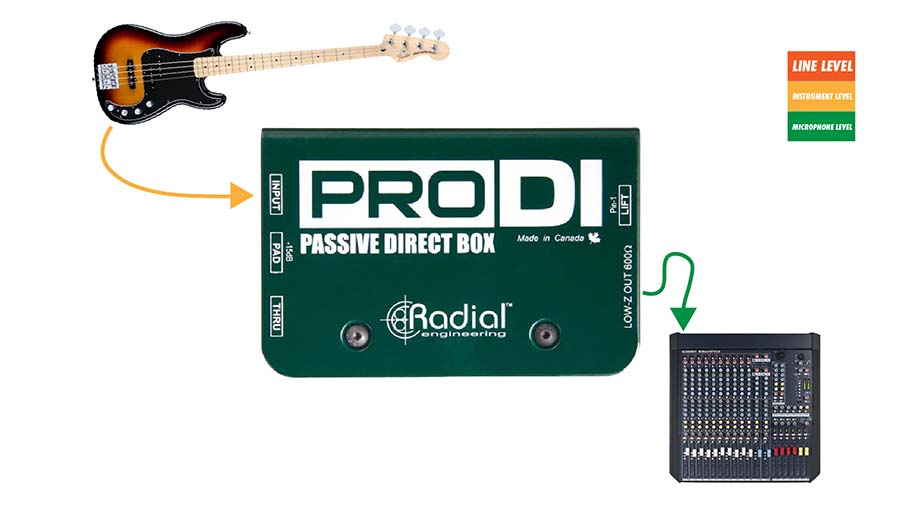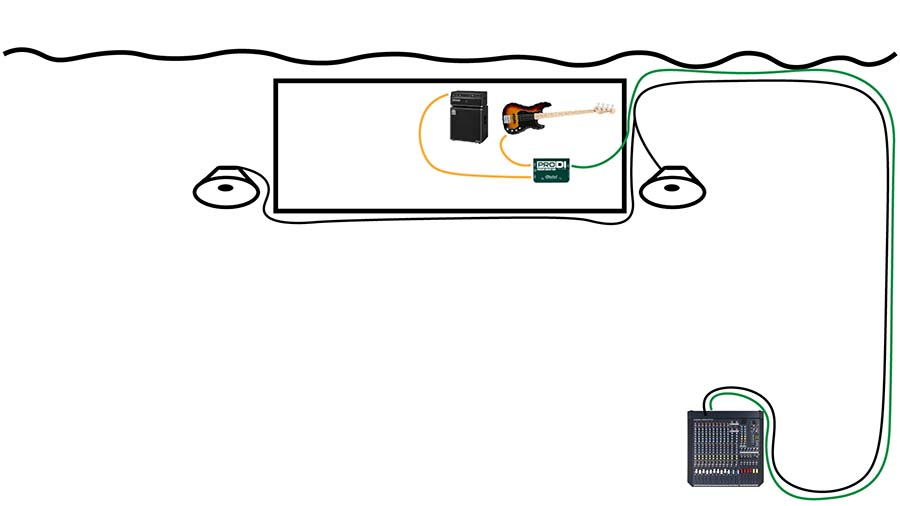What Is A DI box?
A DI box, or direct box, is a device that converts a high-impedance instrument level signal to a low-impedance microphone level signal, and also balances the signal in the process.
A DI box is one of the most useful tools you can have, both for live sound and in the studio. Let’s take a look at when and how to use a direct box. Along the way, we’ll listen to some audio examples so you can decide if you really need one.
Here is a list of my favorite DI boxes for a range of budgets: Which DI Box Is Right For You? | Best Direct Boxes For Studio & Live Production

One of the most common ways to use a DI box is to connect a bass guitar or electric guitar to a microphone input. Why would you want to do that? There are a few reasons…
Maybe you want to preserve a direct signal that isn’t affected by the instrument’s amplifier so that you can re-amp it or pass it through an amplifier plugin later on. Or perhaps you just want a clean signal that isn’t susceptible to leakage from nearby instruments.
There are just a few problems with connecting an instrument directly into a microphone input…
First of all, the pickups on the bass guitar or electric guitar output a high-impedance instrument level signal, while the microphone input on your mixer is designed for a low-impedance microphone level signal.
This is where the DI box comes in… The DI box is essentially a transformer that will convert the high-impedance instrument level signal coming from the instrument into a low-impedance microphone level signal.
Most DI boxes will also have a thru output – that way, you’ve got a low-impedance mic level signal that goes to your mic input and a high-impedance instrument level signal that goes to your amp like normal.

Some DI boxes even work in reverse, allowing you to convert low-impedance to high-impedance. That means that, once you’ve got a direct signal recorded, you can use a passive DI box like this one to send the recording back through an amplifier and record that amplifier with a microphone.
A DI box has another benefit aside from proper impedance matching… It also balances the unbalanced signal coming from the guitar.
I made a full post about balanced connections and how they work if you want to learn more. The important thing to know here is that a balanced signal can travel much further than an unbalanced signal without picking up too much noise.
So, let’s imagine you want a direct signal from an instrument on stage at a concert or an instrument in the tracking room at a studio. If you try to run an instrument cable longer than about 20 feet, it will start to pick up a lot of noise along the way.

Using a DI box, you can keep the unbalanced connections short (from the instrument to the DI and from the DI to the amp) while running the balanced output of the DI the long distance to the mixer input.
This can be helpful for just about any signal source that needs to travel over a long distance. If you need to send the signal from a keyboard, a smartphone, a laptop, a TV, or anything else with an unbalanced output, a DI box is an easy way to balance the signal.
Another advantage of a passive DI box like this one is that the transformer isolates the input signal from the output. There is no direct connection between the input and output, which means the direct box can eliminate buzz and hum caused by ground loops. So, if you’re hearing a buzz, you might try putting direct boxes in the audio connections between various devices.
Active vs Passive DI Boxes
There are two main types of DI boxes I want to talk about in this video: active and passive.
An active DI box has a built-in preamp that boosts the signal of the instrument before it is sent to the mixer. This can be useful if the instruments output a particularly weak signal. Active DI boxes require a power source, such as a 9V battery, an external power supply, or phantom power from a microphone input. Active DI boxes are generally more versatile and can handle a wider range of input levels and impedances.
On the other hand, a passive DI box does not have a preamp (or any active circuitry) and simply converts the signal from high to low impedance without boosting the level. Because there is no active circuitry, a passive DI box doesn’t require a power source. They use a transformer to convert the signal, which can be a more transparent way of processing the signal, but they may not be suitable for instruments with weak outputs or for situations where extra gain is needed.
So, which one is right for you? It really depends on the situation. A general rule is to use a passive DI for active sources and an active DI for passive sources. I encourage you to experiment though. I’ve had great results with these passive DIs – the Whirlwind IMP-2 and Radial ProDI – on all kinds of sources. One of my personal favorite DI boxes is this active RNDI, which has some more advanced features that I’ll show you in the next video.
Here is a list of my favorite DI boxes for a range of budgets: Which DI Box Is Right For You? | Best Direct Boxes For Studio & Live Production
